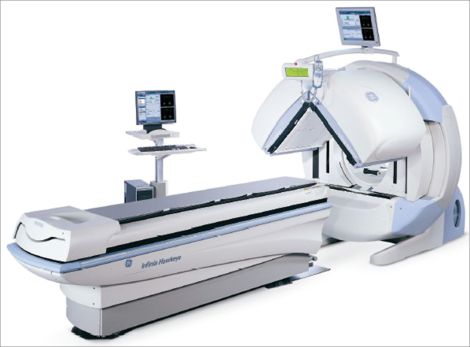A Gallium scan is a radiological procedure performed in the Nuclear Medicine department to help diagnose areas of infection, and some forms of cancer. Gallium scans are done over the course of several days depending on the reason for performing the test.
Your doctor may order a gallium scan to help diagnose:
- Infection in the bone (osteomyelitis); done in conjunction with a bone scan
- Infection/inflammation in the lungs or mediastinum (chest)
- Fever of unknown origin
- Diagnose and stage certain cancers:
- Lymphoma
- Osteosarcoma
- Ewing Sarcoma
- Rhabdomyosarcoma
Preparation
There is no required preparation for a gallium scan; Eat, drink, and take your medications as normal.
PLEASE INFORM YOUR DOCTOR OR THE TECHNOLOGIST IF YOU
ARE, OR THINK YOU MIGHT BE, PREGNANT OR BREASTFEEDING.
Procedure
Check-in at the Diagnostic Imaging Department at the Sault Area Hospital for your appointment.
On the first day, you will be given a very small injection of a radioactive tracer (Gallium-67 Citrate). The injection goes into a vein, and you shouldn’t feel or notice any changes from the injection. Once injected, you will be required to return to the Nuclear Medicine department 2 days later for infection/inflammation imaging or 3 days later for cancer staging.
IF THE AREA OF INTEREST IS IN THE ABDOMEN OR THE TEST IS FOR CANCER STAGING, YOU WILL BE REQUIRED TO TAKE A MILD LAXATIVE THE DAY BEFORE YOU RETURN FOR IMAGING.
When you return for your images, you will be positioned flat on your back on our imaging bed while the images are being taken. You may be asked to move into different positions depending on the area being examined. If the test is for infection/inflammation, images will be taken of the suspected area and can take anywhere from 20 minutes to over an hour.
If the test is for cancer staging, images will be taken of your whole body from head to toe and can take anywhere from 1 hour to 1.5 hours. Wear something comfortable. Sometimes we may be required to perform SPECT (single-photon emission computed tomography) imaging to create a three-dimensional image of a specific area.
For SPECT imaging, the cameras will slowly rotate around you, taking pictures as they go, allowing the physician a more in-depth look at the area. In some cases, we may be required to do a SPECT/CT image of the area. A SPECT/CT image is similar to the SPECT image described above; however, a low dose CT image is acquired after the SPECT image, and the two images are fused together. A SPECT/CT image can further help the physician with a possible diagnosis.
You might be required to return the next day for another set of images if there is a tracer in your bowels and we are examining the abdominal area. The laxative taken the day before imaging should help to clear everything out, avoiding the need to return for an extra day of images.
Following your test, there are no restrictions, and you will be able to drive as you normally would. If you plan to go into the United States of America, you will set off the radiation detectors for approximately 1 month. We can provide a letter explaining why you are setting off the detectors; however, you will still be stopped.
Once your scan is complete, a radiologist will examine it, and a report will be sent to the ordering doctor within a week. Follow up your test with the ordering physician or your family doctor.
The Injection
The amount of radioactive tracer injected for a gallium scan is small enough that there are no additional requirements or precautions to protect others from radiation exposure. The radiation exposure to you is a little more than a standard chest x-ray and less than half of that from a CT scan. The tracer is very slowly cleared out of your body over the course of a month; during that time, you shouldn’t notice or feel anything from the tracer.
Allergic reactions to the material are extremely rare, and you should not feel anything or notice any changes from the material injected.
The radioactive tracer tends to bind to white blood cells (leukocyte lactoferrin) and also goes to areas of rapidly dividing cells (cancers listed above). This allows for the Gallium-67 to concentrate in areas of infection/inflammation and areas containing certain types of cancers listed above.
The Camera
For a gallium scan, we acquire the images using a gamma camera. A gamma camera is a type of radiation detector used to show us how the radioactive tracer is distributed throughout your body. Our cameras do not emit any radiation unless performing a SPECT/CT and are not a hazard to anyone in the vicinity while acquiring. Additionally, our cameras do not make any loud noises. The cameras we use have 2 detectors: one above you and one below you. Dual camera heads allow 2 views to be acquired simultaneously and for SPECT imaging to be acquired in half the time.

